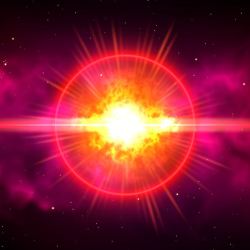In late 2019 Betelgeuse, a star within the Orion constellation, grew dim, leading to speculation that its life might be at an end and it would become a supernova. The dimming, now felt due to “dust” and stellar activity obscuring our view, has resolved. Not so the concerns over Betelgeuse.
When I was five or so, my father bought a telescope; he put it together and, that night, we took it into the backyard – I don’t remember the first thing we looked at but, when I looked through the eyepiece during the evening and saw Saturn floating there close enough to touch…I was hooked. Over the next many years, I became familiar with the sky, and it didn’t take long for me to become enamored of the constellation Orion, including the ruby-red star anchoring Orion’s left shoulder – Betelgeuse.
Virtually everything about a star is determined by its mass – massive stars like Betelgeuse blaze a brilliant blue-white, burning through their fuel at a profligate rate, giving them no more than a few tens of millions of years of life. When their fuel runs out, they go out in a blaze of glory – a supernova – seen across the visible universe. Betelgeuse is close to that point now, close being for astronomers anytime in the next few million years. Betelgeuse has been acting erratically of late, and there are those who think we might see it light off within a few decades.
Supernova
Supernovae give off so much energy they can be seen across the universe. This energy made it possible for astrophysicists Saul Perlmutter, Adam Riess, and Brian Schmidt to determine that the universe is expanding ever more rapidly as it ages (a discovery for which they earned the 2011 Nobel Prize in Physics). So, it’s natural to wonder how bad it will be when Betelgeuse explodes – will it sterilize the entire galaxy, a quadrant, or only its local neighborhood? And since Earth is in Betelgeuse’s “neighborhood,” will it also take us out?
As best we can tell, the prognosis is not too bad for Earth.
While Betelgeuse is a relatively nearby star, it’s still several hundred light-years away from us, and even one light-year is nearly 6 trillion miles – more than 1000 times as far away from us as Neptune. After traveling hundreds of light-years, the energy and the radiation produced by the blast of an exploding star will diffuse to the point of being…not inconsequential but certainly not lethal to those of us on Earth. Even a radiation exposure that would be fatally high to anyone (or anything) in orbit, after filtering through 60 or so miles of atmosphere, the dose of radiation on the Earth’s surface will be easily survivable. Anything more distant than about 100 light-years is unlikely to cause harm at the Earth’s surface, and Betelgeuse is comfortably further than that.
Something else to be concerned about is that the flood of ultraviolet and x-ray radiation from a nearby supernova can strip away Earth’s protective ozone layer – but Betelgeuse is too far away to inflict this on us. Another possible source of radiation, radioactive debris thrown into space, will be too scant to cause problems here on Earth. The bottom line is that when Betelgeuse explodes – next week, next decade, or in a million years – it will be the brightest star in the sky…and that’s likely to be the only impact it has on us.
There’s no doubt that supernovae have gone off in our vicinity repeatedly in the past. Astronomers have found traces of radioactive elements created during these explosions in deep-sea sediments, and some have suggested that at least one (and possibly multiple) of Earth’s mass extinctions might have been triggered by a nearby supernova or gamma-ray burst. Not only that, but our Solar System is inside a void, a “local bubble,” likely excavated by a series of supernovae going off over a few million years; their effect on Earthly life, though, is unknown.
Returning to the main concern, the pending explosion of Betelgeuse promises to be a spectacular event that we can enjoy from the safety of our location at the bottom of the atmosphere. And fortunately for our astronauts, their radiation exposure is likely to be higher than we’d prefer to see it…but not likely to make them ill, and certainly not enough to be fatal.
This means we can all relax and enjoy the show!

